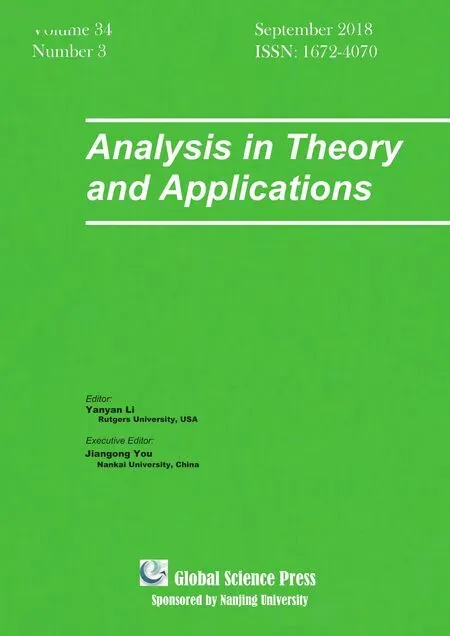Decomposition Formulas of Kampé de Fériets Double Hypergeometric Functions
Maged G.Bin-Saad,Anvar Hasanovand Mamasali Turaev
1Department of Mathematics,Aden University,Kohrmakssar,P.O.Box 6014,Yemen.
2Institute of Mathematics,National University of Uzbekistan,29 Durmon yuli street,Tashkent 700125,Uzbekistan
3Institute for Advanced Studies,100021,Tashkent,Spitamen str.16 Uzbekistan
Abstract.This paper is sequel to the authors paper[18].By using the generalized Burchnall-Chaundy operator method,the authors are aiming at deriving certain decomposition formulas for some interesting special cases of Kampé de Fériets series of double hypergeometric series Fp:q;kl:m;n.
Key Words:Generalized hypergeometric function,Kampé de Fériets functions,decomposition formulas,inverse pairs of symbolic operators.
1 Introduction and preliminaries
A great interest in the theory of hypergeometric functions(that is,hypergeometric functions of one and several variables)is motivated essentially by the fact that the solutions of many applied problems involving(for example)partial differential equations are obtainable with the help of such hypergeometric functions(see,for details,[25,pp.47-48]].Also,in this regard,it is noticed that the general sextic equation can be solved in terms of Kampéde Fériet function(see[5]).We recall here the Kampé de Fériets function of double hypergeometric series defined by(see[2]and[24]):

where for convergence

or

and

(a)ndenotes the Pochhammer symbol given bya nd Γ is the Gamma function,with similar interpretations for((er))r+s,et cetera.
Note that,the Kampé de Fériets function of double hypergeometric series(1.1)is a generalization of Appell's four double hypergeometric series F1,F2,F3and F4(see[2,25]).
A decomposition formula for a hypergeometric function is the one which describes the hypergeometric function with a summation of same or other hypergeometric functions.It was started to study by Burchnall and Chaundy in 1940 for Appell's double hypergeometric functions(see[4,5])and Chaundy[7].Recently,it has been studying for various special functions by many mathematicians(see[1,3,8-22]).In particular,Hasanov and Srivastava[13,15]presented a number of decomposition formulas in terms of such simpler hypergeometric functions as the Gauss and Appell's functions and Choi-Hasanov[8]gave a formula of an analytic continuation of the Clausen hypergeometric function3F2as an application of their decomposition formula.In[3],using the differential operator D and its inverse D-1(defined as the integral operator and setting the lower limit to 0),Bin-Saad develops techniques to represent hypergeometric functions and their generalizations with several summation quantifiers.Here the operator(and combinations of it)is applied to simpler expressions like,e.g.,products such that its image produces the desired series.In addition,new decomposition formulas are presented.Various examples illustrate how these techniques can be applied(see[3]).In[8]the authors introduced the following symbolic operators:

Based on the operators defined in(1.2a)and(1.2b),we aim in this paper to study similar type of decomposition formulas to Choi-Hasanov ones[8]for the Kampé de Fériets double hypergeoemtric series(1.1)proved by using the theory of symbolic operators.
2 A set of operator identities
By using Burchnall and Chaundy[4]and[5]and Chaundy[7]method together with symbolic operators(1.2a)and(1.2b),we find the following set of operator identities and decomposition formulas for a number of interesting special cases of Kampé de Fériets double hypergeometric function






3 Decomposition formulas via operator identities
In[22,pp.93],it is proved that,for any analytic functions f,the following equalities hold true:

In view of formulas(3.1a)and(3.1b),and taking into account the differentiation formula for hypergeometric functions,from operator identities(2.1a)to(2.3h),we find the following decomposition formulas:









Finally,let us stress that the schema suggested in Sections 2 and 3 can be applied to find symbolic operational images and expansions for other hypergeometric functions of double series related to Kampé de Fériets series of double hypergeometric series
In a forthcoming papers we will consider the problems of establishing symbolic operational images and expansions for other generalized hypergeometric functions of double and triple series by following the technique discussed in this paper.
Acknowledgements
The authors are extremely thankful to the reviewers for their useful comments that improves the quality of the manuscript.
 Analysis in Theory and Applications2018年3期
Analysis in Theory and Applications2018年3期
- Analysis in Theory and Applications的其它文章
- Existence of Solutions for Fractional Differential Equations Involving Two Riemann-Liouville Fractional Orders
- Domain of Euler Mean in the Space of Absolutely p-Summable Double Sequences with 0<p<1
- Erd?s Type Inequality for Lorentz Polynomials
- Some Characterizations of Bloch Functions
- Weighted Boundedness of Commutators of Generalized Calderón-Zygmund Operators
- Hopf Bifurcation of a Nonresident Computer Virus Model with Delay
